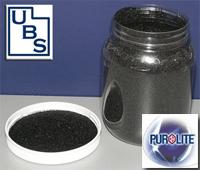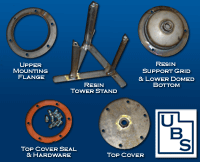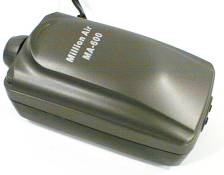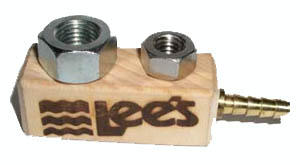In all my time doing Biodiesel, it seems there's always something new and exciting that comes out to make our lives better. The latest & greatest new technique is called dry washing. We've been researching this technique quite a bit and think it shows promise.
Dry Washing Defined:Dry washing is the process of washing reacted Biodiesel of it's contaminants before it's ready for use. These contaminants include trace amounts of methanol, soap, glycerin, catalysts, and anything else that isn't Biodiesel. It's done through various ways and methods, but today we'll be concentrating on how it's performed when using dry wash columns and dry wash media.
Dry Washing Media:This is the stuff that does the actual "washing". There's several different kinds of it, so lets get started....
Absorbents:These media types literally absorb the bad stuff out of the Biodiesel. It's a lot like a filter works.
MagnesolThe first to make the scene on the Biodiesel stage was a product called
Magnesol. It's made of a fine powder of Magnesium Silicate (Yep! Same stuff that's in sand blasting powder and talcum powder!). This did an INCREDIBLE job of absorbing all the bad stuff out of Biodiesel and people flocked to it like crazy. Both small and large Biodiesel producers thought it was the greatest stuff in the world.....until they tried to get it back out!
You see Magnesol is an absolute BEAST to try & filter back out of the Biodiesel. Because the magnesium silicate particles are so small (remember, it's basically artificial sand) it'd find it's way right around fuel filters and into the finished Biodiesel. It was hard to detect it because it's such a small powder, but let a batch of Biodiesel sit for about a month and the fine silt would settle to the bottom. Even when 1 micron filters were used this sneaky stuff would still find a way to get past them! So, Magnesol lost credibility amont Biodiesel producers. You may see ads for it here & there in magazines and some places online will even make you a screaming great deal on it. Don't take the bait. Your diesel engine will thank you!
Eco2PureThe next one to appear on the Biodiesel scene was a product called Eco2Pure. This one came out of Europe from a company called Filtertechnik. It's basically just Red Oak Wood Chips with some molecular sieves in it (some suspect the sieves are a Zeolite type of a product). Filtertechnik trumped this new product to the nth degree claiming it was the new panacea for dry washing, but, like anything out there, there were some trade-offs.
When originally released, Filtertechnik published some amazing numbers for usage rates; somewhere in the neighborhood of being able to filter something like 2500-3000 gallons of Biodiesel before needing to be replenished. Unfortunately, it turned out to be more like 1,000 to 1500 gallons. Other problems with Eco2Pure included not being able to get the stuff back out of the towers once it was used up (because it turned into a solid log-like substance; remember, these are wood chips, throw in some Biodiesel and they'll swell). Other problems include that it just plain and simple won't suck out all the soap; some of it just gets by.
Others have tried their own versions of just wood chips and other absorbents with a fair amount of success. For the most part, Eco2Pure works, but it works best when teamed up with some other media as well; such as an Ion Exchange resin, which is the next category we'll discuss.
Ion Exchange Media:This type of media is a bead like substance that works by chemically altering the soaps and absorbing the glycerins out of the Biodiesel. It's typically in bead like form and can be either a "gel resin" (meaning a solid bead), or a "porous resin" (meaning a bead with lots of holes).
How They WorkThese resins are impregnated with a chemical (usually Sulfuric Acid) that literally can change the soap in Biodiesel back into a free-fatty acid through a process called Ion Echange. It works by ripping the Sodium or Potassium Ion off of the soap molecule that's in Biodiesel and then replaces it with a Hydrogen Ion. By doing this, you literally convert the soap back into an acid.
The resins also work by absorbing any glycerin into the beads as well; working much like the Eco2Pure media above. However, these resins DO NOT absorb high amounts of Methanol. In fact, if the methanol levels are too high, the soaps & glycerins won't be removed very well either, so it's important to note that while Ion Exchange Media will remove soaps and glycerins, it's lousy at getting rid of methanol.
Below are the types of resins we're aware of on the market.
Amberlite BD-10 Dry
Produced by Rohm & Haus, this was the first gel type resin to hit the scene.
This gel-type resin kicked everything off for Ion Exchange Resins and Biodiesel. It quickly became popular as a great resin; so popular that it was quickly followed by several competitors.
While Amberlite BD 10 Dry was a smash hit right from the start, it was manufactured in Germany making it next to impossible to get your hands on it. This was especially the case for small scale Biodiesel producers. For a time we partnered with a Biodiesel coop in Denver to bring it to our customers but once the supply dried up, it was gone.
You can read more about Amberlite BD 10 Dry here:Purolite PD 206Purolite PD 206 hit the scene fairly soon after Amberlite. This new resin was

manufactured by the Purolite Company out of Pennsylvania. It became a much easier resin to get ahold of and companies quickly embraced it as a replacement to the somewhat expensive and hard to get Amberlite product.
A few months ago we teamed up with Arbor Biofuels Company to bring it to our customers and have seen it become very popular.
You can read more about Purolite here: Thermax T-45 BD Macro-Porous
Thermax is one of the newest resins to come on the scene and has been making quite a splash. Instead of being a solid bead-like resin, these beads have pores in them; like a Wiffle ball!
The pores give Thermax much better surface area to work with and allow the Biodiesel to be cleaned in a better fashion. Because it's a porous material, it also allows for better flow properties and isn't nearly as susceptible to compacting in a column like Amberlite or Purolite would be.
A great article was written by Arbor Biofuels Company, the US distributor for Thermax on why it works so well:
Click here to read the articleYou can also read more about Thermax here:There are also some new ion exchange resins coming to market, but we haven't had a chance to test any of them, but a Google search for Biodiesel Dry Wash Resin will turn up a whole host of them.
Dry Washing Equipment:To dry wash Biodiesel, you'll need a container to house the dry wash media in and flow the Biodiesel through. You'll also need a mesh screen at the bottom of the container to keep the dry wash media in the container and out of your Biodiesel once you're done washing with it.
Initially, people were using PVC tubes, but quickly discovered that Ion Exchange Resins would blow the sides of them out and deteriorate them due to compacting and the Sulfuric Acid ions eating away at the filters.
For the most part, the recommended solution for dry washing is using steel metal tubes. If you can swing it stainless is also nice, but expensive, so cold or hot rolled steel will work just fine. Most media recommends "3 to 1" dimensions (3 times the diameter for the height).
A really good article by Arbor Biofuels was written on sizing columns correctly here.
Click here to read the articleWe sat on the sidelines for quite a while waiting for the market to get many of the kinks worked out. After that happened we decided to go with two vendors of dry wash columns and media.
Arbor Biofuels CompanyArbor Biofuels has done some incredible research in the field of small scale Biodiesel production and dry washing. They've tried just about every resin under the sun and have kept meticulous research data on the results.
We've partnered with them to bring you several different customized dry wash towers. Four tower options are available for the Ion Exchange Resin and one option is available for Eco2Pure.
Ion Exchange Resin Towers & Tower Kits
 3 Complete Towers 1 Dry Wash Resin Tower Kit
3 Complete Towers 1 Dry Wash Resin Tower KitWe now offer 3 completely built Arbor towers. A 6", 10", and 12" diameter setup. We also offer a 6" Tower Kit that will allow you to build your own.

Arbor's Eco2Pure Tower has a specially designed fitting inside that makes removal of the Eco2Pure much easier. 33 lbs of Eco2Pure will typically purify about 1,000 to 1500 gallons of Biodiesel. The towers are able to hold about 10 lbs of Eco2Pure, so you can expect about 500-700 gallons purified before needing to swap out the media.
Life expectancy of the media will largely depend on how well reacted your fuel is as well as how much soap and contaminants you're producing as well. It's a good product to work with but works best when teamed up with an Ion Exchange resin such as Thermax.
You can learn more about the Eco2Pure Tower hereSpringboard BiodieselSpringboard Biodiesel, makers of the BioPro line of Biodiesel processors, has just come out with a new dry wash combo tower called the Spring Pro T76.

This unique tower combo is a set of 10" columns that stand a little over 6 feet tall. The towers come pre-assembled and connected to a stand that utilizes a new swivel technology called Theta Lock that they created.
Inside the tower on the left, they utilize Eco2Pure and on the right is Thermax. The system works extremely well to remove the glycerin's and soaps from Biodiesel and fits well with a BioPro. Something unique to this system is it's turn-key design.
They've incorporated a pumping system that can be purchased with it for a little extra that will allow you to connect the towers to any Biodiesel processor and begin dry washing almost immediately. They also offer the option to pre-treat the media according to the manufacturers guidelines as well so that it's ready to go when it shows up on your end.
The Methanol Issue:While dry washing Biodiesel does an outstanding job of removing glycerin and soap, it DOES NOT remove methanol. In some cases the Eco2Pure will absorb a little, but definitely not enough to bring the fuel into ASTM Specifications. For this reason,
it is important that you have some sort of a plan in place to deal with methanol in the Biodiesel.
According to
Springboard Biodiesel, "
Typically, unwashed biodiesel will contain 1-1.5% or higher residual methanol
by volume. If this is not removed, the biodiesel will not comply with ASTM D6751.
ASTM D2887, ASTM D2887M, EN14110, ASTM D93, and ASTM D613 are all sections of the ASTM D6751 standard which may be adversely effected if residual methanol is not removed from the finished fuel."
To give you an idea of how much that is, if you had 100 gallons of
unwashed Biodiesel, and methanol levels were at 1%, that's a full
gallon of Methanol in the fuel. While there have been several studies performed, I have yet to see much conclusive evidence that having that much methanol in the fuel really causes any problems. In fact, pre-detonation (pinging) isn't really an issue because the fuel in a diesel engine all gets injected at the same time (at the top of the combustion stroke). In some cases it may cause the engine to burn hotter (ie. hotter Exhaust Gas Temperatures), but there's been relatively little evidence that supports any problems with methanol at this level being in the fuel.
That said, methanol is a solvent and, like Biodiesel, can erode away some metals and rubber seals. However, the REAL issue here is what elevated methanol levels can do in dry washing.
Methanol is the recommended solvent to clean out dry wash ion exchange columns. Because of this, if methanol levels in the Biodiesel are too high (much higher than 2%) before dry washing, the methanol can actually inhibit the exchange resins from doing their job. In otherwords, part of the soaps and glycerin will just sail right on past the dry wash media and straight into the finished fuel. It is for this reason that we highly recommend some sort of a demethylization process either before or after using an ion exchange dry wash system.
Recommended Methods For Removing MethanolThere are several ways to eliminate methanol from raw Biodiesel. Here's a few that we know work well.
1) The 5% Prewash MethodThis method is the easiest to do and seems to work the best. It involves adding some water to the Biodiesel just before settling the glycerin out of the Biodiesel.
Here's how to do it:A) Identify how much Biodiesel is in your main tank
B) Just before you turn off your mixer or pump from mixing the methoxide in, you add 5% by volume of water to the main tank.
C) Continue mixing for about 10-15 minutes
D) Turn off the mixer or pump and let it settle as normal
EXAMPLE:If you were making 50 gallons of Biodiesel, 50 x .05 = 2.5 gallons.
This means just before turning off the mixer you'd add 2 1/2 gallons of water to the processor and mix for about 10-15 minutes. Then let it settle as normal.
Click here for more information on how it works2) Air BubblingThis method is simple. Just get an air bubbler of some sort, hook it to something that produces air, and bubble your Biodiesel for hours on end. The bubbling will help evaporate the Methanol out of the Biodiesel and soon you'll be methanol free

 We carry bubblers
We carry bubblers, but an air compressor will work too.
3) Lots Of Time & SettlingIf Biodiesel is allowed to settle long enough in an open container, a large portion of the Methanol will simply evaporate. It could take a while (depends on air temperature, humidity, etc) but it can happen.
Our Dry Washing RecommendationIf you're water washing your Biodiesel and it works; there's no need to go to a dry wash system. In other words, "If it ain't broke, don't fix it!"
However, if you're having a problem disposing of your wash water or if you need to speed up the process a little, then dry washing your Biodiesel may be the answer.
At it's best though, dry washing can only equal water washing...to a point. Water washing removes methanol, glycerin, and soaps. Dry washing misses the methanol so you're required to add another system in place to get the same results as water washing.
If you do choose to go with a dry washing solution, the solution that seems to be the most effective to date for small scale production is to use two towers in a lead/lag setup and put Eco2Pure media in the first tower and Thermax in the second tower. These two in combination seem to be delivering the best bang for the buck and working the best together.
Granted, it's still not perfect and you still will need to come up with a way to get rid of the methanol, but if you're bound & determined to go dry wash, Eco2Pure with Thermax is an excellent start!
If you'd like to learn more about dry washing Biodiesel, there's a whole section devoted to it on our favorite Biodiesel forum.
Click here to see the discussion area for dry washing